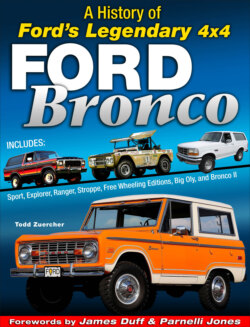Читать книгу Ford Bronco: A History of Ford's Legendary 4x4 - Todd Zuercher - Страница 12
На сайте Литреса книга снята с продажи.
Development
ОглавлениеDetails on the timeline of the Bronco’s original development cycle are limited as the design principals involved are deceased. The earliest mention of the Bronco in Ford official documentation is October 1963.
Minutes from the February 12, 1964, Product Planning Committee (comprised of top Ford Motor Company planning executives) meeting reveal that a five-year vehicle life cycle was assumed for financial planning purposes but that Ford thought the Bronco would run for much longer than five years. Ford believed that the International Harvester Scout and Jeep would not change much in the following years, giving Ford a competitive advantage with the Bronco that would last for several years. Ford president Lee Iacocca remarked that if the Bronco was successful, General Motors would enter the market within a few years, and he felt that Chrysler would not be a threat to Ford’s sales for a long time. Remarkably, all of these predictions came true in the following half-dozen years. At the conclusion of the February 12 meeting, the Product Planning Committee viewed the first styling model of the Bronco in the Rotunda styling studio and gave its approval. Ten days later, the committee gave its approval for a $10 million proposal to develop the Bronco.
Meanwhile, engineers were already hard at work on the design aspects of the new filly. According to notes of the Advanced Development Group in April 1964, the full-size chassis layouts of major components were completed for a mechanical prototype build, and feasibility of the new Mono-Beam/coil-spring front suspension was verified during the first quarter of 1964.
Believed to be the earliest known photo of a Bronco, this shot from Ford’s styling studio shows what Ford’s stylists were thinking in 1964. No drivetrain exists in this mockup and it’s likely made of clay. In this view, you can see the 1966-only liftgate latch assembly and the full door has been mocked up. Hubcaps are from a Ford car. (Photo Courtesy Ford Motor Company)
Looking remarkably similar to production trucks, sharp-eyed readers can note some differences. The grille treatment looks familiar but changed for production. The driver’s side of the Bronco has the 1967-and-later-style hubcaps and a mockup of the fiberglass door insert used in the 1966–1968 roadsters. (Photo Courtesy Ford Motor Company)
In a Society of Automotive Engineers (SAE) paper published in early 1966, Ford engineer Paul Axelrad noted that no less than 10 complete package layouts were made before the final selection was determined. With an overall length of 152 inches, the wheelbase was expanded and contracted on several occasions before 92 inches was selected as the final number. The engineering team found 92 inches gave a good balance between approach, departure, and ramp break-over angles.
The break-over angle was determined to be the most important of the three based on Ford’s owner surveys and internal testing. Thus, Ford designed the Bronco to beat or equal the break-over angles of its primary competitors (the CJ-5 and Scout). In addition, Ford engineers carefully considered the various interactions of wheelbase, track width, and wheel turn angle to meet the Bronco’s design goals of maneuverability, ride comfort, and stability.
Retired Ford engineer Larry Wynne worked in Light Truck Engineering during those years and recalls that five or six engineers, under the leadership of Group Leader Paul Axelrad, were responsible for the mechanical development of the Bronco. Wynne notes that Light Truck Engineering consisted of only about 35 to 40 engineers during that time and his memory of those long-ago years was that the Bronco was not the primary focus during those years; that honor belonged to the Twin I-Beam front suspension that debuted on the Ford light-duty pickup trucks in 1965.
Wynne’s strongest memory from the Bronco development story isn’t of engineers sitting at desks crunching numbers or creating drawings, but instead it involves a test trip out West with prototypes of the new trucks. A caravan of three Broncos along with a Scout and a Jeep were the test vehicles. In Arizona, the vehicles were traversing rough terrain when the Scout rolled on a hillside and several men were injured. One man broke his collarbone and another broke his pelvis and right arm. According to another engineer’s account, Axelrad himself rolled one of the vehicles and was knocked unconscious.
Due to the first generation’s unique styling, many people believe that the Bronco was a wholly unique vehicle that didn’t share many parts with other existing Ford vehicles. However, Ford initially intended to use as many existing parts as possible to minimize the fixed investment. The rear quarter panels from the 1964 F-100 Styleside box were reused with some minor modifications for the sides of the Bronco body. Floorpan assemblies and the tailgate (both resized) from the same truck were also used.
Ford outsourced engineering design services for the body-in-white, seats, trim, and body electrical system to the Budd Company in Philadelphia, Pennsylvania. Budd built engineering prototype bodies using reworked 1964 Styleside F-100 sheet metal. The front-end sheet metal for the initial prototypes was made from low-cost tooling produced from plaster casts of the clay model.
For the production trucks, the engines were modified versions of powerplants already offered in Ford’s lineup. Exterior items such as headlights, trim rings, turn-signal lenses, and taillight lenses were reused from Ford’s car and truck models. The bucket seats in the 1966 Bronco were two Mustang buckets. Knobs on the dash and the instrument cluster were also borrowed from the Ford light truck cab. Even small items such as the transfer case shifter knob came from the existing Ford parts list (F250 4x4).
The Budd Company did much of the development work on the Bronco prototypes for Ford and also built Bronco bodies for Ford for the first several months of production in 1966. This rare ad highlights Budd’s relationship with the Bronco and other 1960s vehicles.
